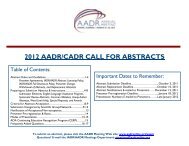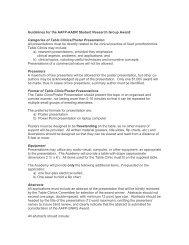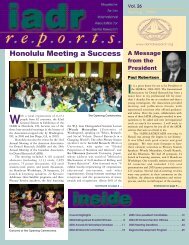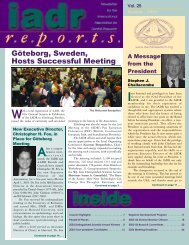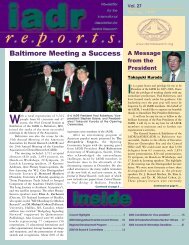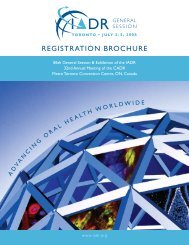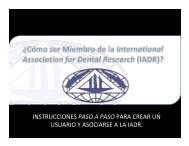Contents - IADR/AADR
Contents - IADR/AADR
Contents - IADR/AADR
You also want an ePaper? Increase the reach of your titles
YUMPU automatically turns print PDFs into web optimized ePapers that Google loves.
necessary for physicists to further refine measurements. Perhaps no better example of this weakness may be<br />
offered than that of Alfred Russell Wallace, who, summarizing the scientific achievements of the nineteenth<br />
century in 1901, pointed to the rejection of the study of phrenology by the scientific community as one of the<br />
most unexplainable failures of an otherwise brilliant period. For Wallace at the opening of the twentieth century<br />
it seemed that phrenology had been one of the greatest scientific breakthroughs of the preceding seventy years.<br />
But if some scientists had developed a sense of complacency by the turn of the century, and if others were<br />
willing to judge the developments in fields other than their own with something less than the eyes of experts,<br />
the scientific world was in reality in the opening stages of what may now be called a second revolution in<br />
science. Surely many factors contributed to this development, but for the purpose of this short essay we may<br />
limit ourselves to only a few. Above all, looking back from the third quarter of the twentieth century, it is<br />
obvious that a number of spectacular discoveries sparked by scientific genius contributed to a rapid series of<br />
advancements. Classical concepts in the physical sciences were overturned in the closing decade of the old<br />
century and the opening decades of the new one. In their place new concepts, hypotheses, and theories were<br />
postulated at a pace that bewildered the scientist then, no less than it does the historian today who attempts to<br />
reconstruct that era. And yet perhaps no less important for an understanding of twentieth-century science than<br />
these internal developments within the sciences were the parallel origins of a new union of science, industry,<br />
and government in the late nineteenth century—a union that was essentially nonexistent in earlier periods. Here<br />
the result was to create a demand for scientists that the universities with new teaching methods quickly filled.<br />
And, as newly research-oriented industries began to affect the economic well-being of nations, scientific<br />
research inevitably became a matter of concern to politicians and their governments.<br />
It would be impossible to list adequately the major scientific developments of the past eighty years. At<br />
best one can point to a few of the more significant areas of change. Nowhere had change been less expected<br />
than in physics. Here the spectacular discovery of X-rays by Roentgen in 1895 quickly impressed itself on the<br />
scientific world as well as the public. While music-hall comedians pointed to the girls in the chorus and sang<br />
songs such as "X-Rays Will Give It Away" (ca. 1899), scientists were engaged in work which led in turn from<br />
radioactivity to a whole set of new elements and then on to the problems of nuclear physics. In the course of a<br />
few decades this discovery resulted in a knowledge of how atoms are arranged in solids. And, if we may trace<br />
these developments through to the solid-state physics of the present, we may point to a second contemporary<br />
major development in the physical sciences in the early part of the new century. At that time a new synthesis of<br />
the relative character of motion and of the relationship between mechanics and optics led to both the special and<br />
the general theories of relativity. With the latter, a far more satisfactory explanation of cosmological phenomena<br />
has been made possible. In chemistry, as the fields of biochemistry and physical chemistry developed, a heavy<br />
emphasis has been placed on structural problems. The search for answers to biological questions through the<br />
INTERNATIONAL ASSOCIATION FOR DENTAL RESEARCH (<strong>IADR</strong>) – THE FIRST FIFTY YEAR HISTORY PAGE 3



